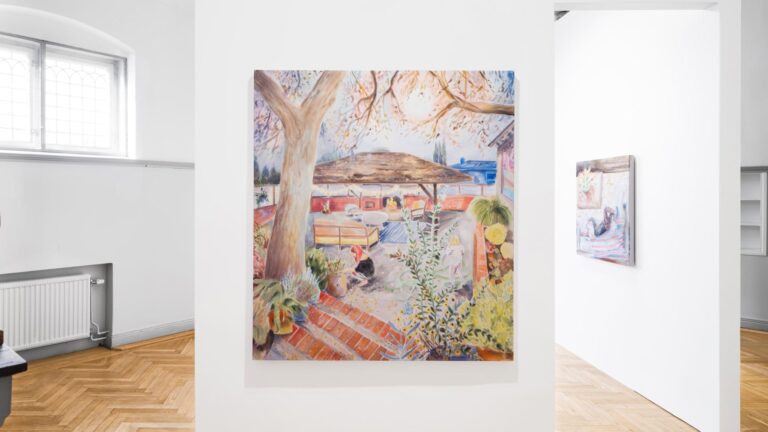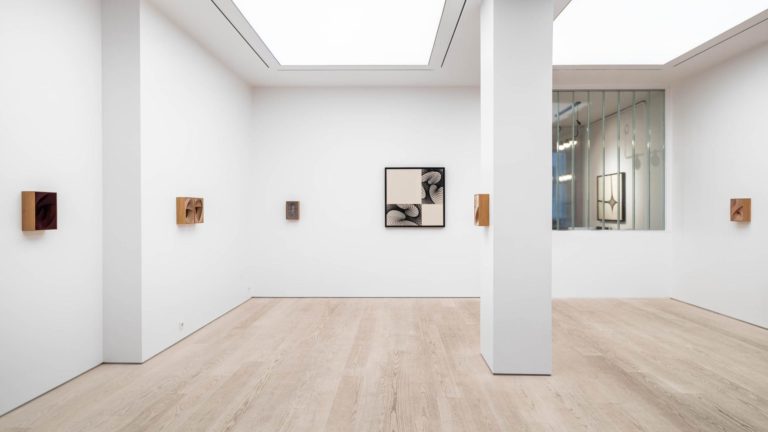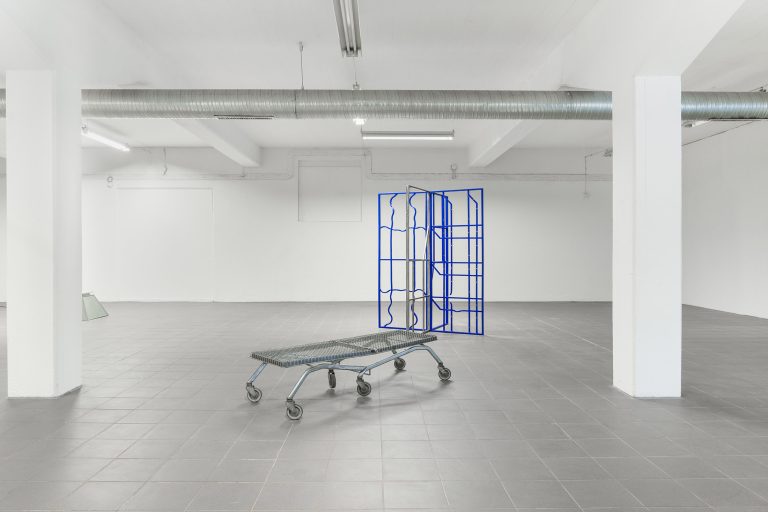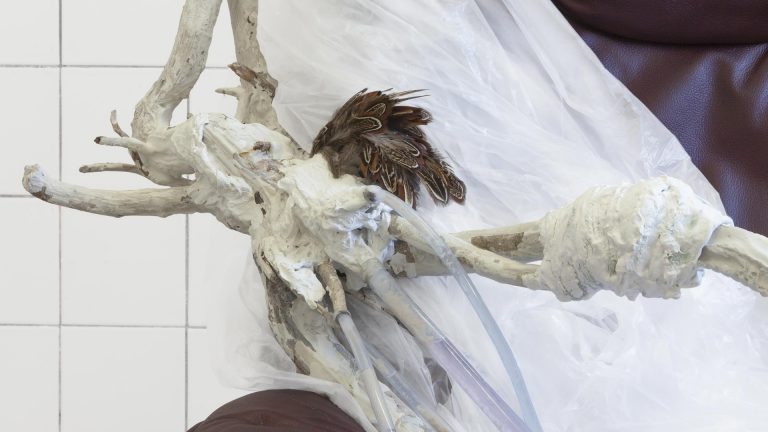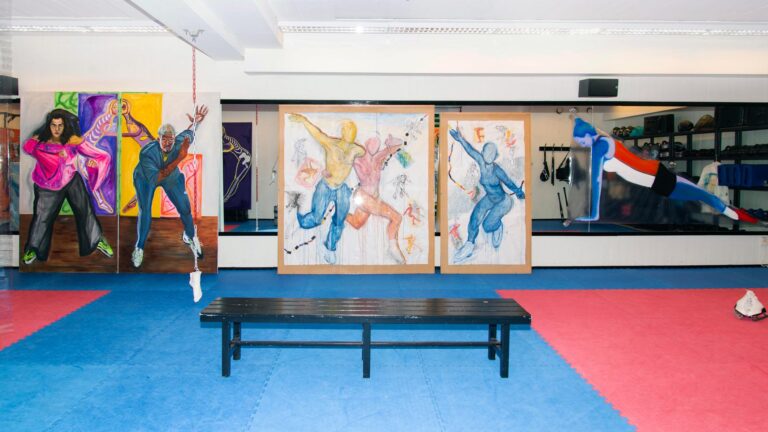Artists: Agnes Denes and Åsa Sonjasdotter
Exhibition title: Exercises in Eco-Logic / Cultivating Abundance
Curated by: Laura Goldschmidt and Åsa Nacking
Venue: Lunds Konsthall, Lund, Sweden
Date: June 1 – August 25, 2024
Photography: all images copyright and courtesy of the artists and Lunds Konsthall
Lunds konsthall is very proud to present two parallel solo exhibitions, one by Agnes Denes (born in Budapest in 1931, grew up in Stockholm, lives in New York) and one by Åsa Sonjasdotter (born in Helsingborg in 1966, grew up in Lund, lives on the island of Ven and in Berlin). In their works, both artists speak of the importance to act in the face of climate change and other destructive processes affecting our surroundings and invite us to think about how we may influence our future.
Agnes Denes is a pioneer within the artistic genre of Land Art and the ecological debate. Since the 1960s she has used artistic as well as scientific, mathematical and philosophical methods to investigate and influence humankind’s impact on the environment.
Åsa Sonjasdotter combines the cultivation of plants with archival research to investigate social and ecological relations and contexts. Her works reactivate overlooked knowledge about cultivation and insists that the genetical information coded into common crops is a memory bank for both humans and plants.
Both exhibitions involve new productions with site-specific dimensions. Denes’s Time Capsule consists of a capsule with messages to the future that will be collected throughout the exhibition. After the collection the capsule will be ritually buried and laid to rest for 1000 years. Denes has also realised the film Bird Migration as a public piece for the City of Lund, based on a concept she formulated already when she lived in Sweden as a teenager.
Sonjasdotter has produced new versions of existing projects around the cultivation of grain, potatoes and kale. The atrium at Lunds konsthall has been converted into a cultivation space showcasing new thinking about how we may relate to what nature offers and what we need. She has also initiated a cultivation project together with the civil society at Brunnshög, and during the exhibition a bus trip will be organised to the Källunda farm in Häglinge, to visit the seed bank and the ongoing work of the Allkorn association.
Agnes Denes: Exercises in Eco-Logic
Lunds konsthall is honored to be able to present a solo exhibition with selected works by Agnes Denes, internationally recognized as the leading pioneer of the environmental art movement. It highlights the increasingly relevant ecological and socio-economic concerns of the artist’s works since the 1960s.
Born in Budapest in 1931, and living and working in New York since the 1950s, Denes spent her teenage years in Stockholm. There she conceived her first environmental work, The Bird Project. It has inspired her newest work, Bird Migration, a poetic discourse on the artist’s personal history told in her own voice and through multiple filmed images of an array of migratory birds. While this work is anchored in the artist’s early life experiences, it simultaneously presents bird formations in the sky as universal signs of departure and temporal shifts. Produced specifically for the exhibition, with the support of Lunds konsthall, it will enter the art collection of the City of Lund.
Since the 1960s, Denes has addressed cultural and social issues challenging global survival. One of the most prominent artists of our time, she is internationally known for works created in a wide range of mediums, investigating science, mathematics, philosophy, linguistics, psychology, poetry, history, and music—virtually all aspects of human endeavor.
In 1968, she enacted Rice/Tree/Burial as a private event in Sullivan County, New York. Acknowledged as the first site work with specific ecological concerns, it announced her life-long commitment to creating environmental works to benefit humanity, as well as the philosophical concept of Dialectical Triangulation that has informed her work to this day. A large-scale version of Rice/Tree/Burial was presented by the artist ten years later at Artpark in Lewiston, New York, adjacent to Niagara Falls which became an added element of the work. Additionally, the artist’s first time capsule, containing the microfilmed responses to a questionnaire on the future of humanity, was buried with instructions to be opened in 1000 years, and commemorated with a plaque on the site.
Denes’s questionnaires and time capsules, forming an ongoing series in which she engages local populations in dialogue with the future, continue to be created for exhibitions and installations across the globe. 39 of the artist’s own photographs documenting Rice/Tree/Burial (1977–79) are on view in the exhibition, which also features a new questionnaire and time capsule, which will then be buried in a suitable place, adding an important dimension to the presentation of her work in Lund.
Denes has created monumental site works around the world but her most iconic project may be the site-specific intervention Wheatfield—A Confrontation from 1982, for which she planted a wheat field in Lower Manhattan, adjacent to Wall Street and the World Trade Center in New York’s Financial District. It confirmed her position as the leading figure within the expanding field of ecologically based art. With its emphasis on socio-economic realities, Wheatfield is another example of Denes’s early concern for the environment that remains inspirational for younger generations of artists, architects, and the public at large. In 2015 it was recreated on 12 acres in central Milan and will be the focus of a new presentation in June 2024 at Tinworks Art in Montana.
To deepen the understanding of Denes’s thinking, the exhibition also includes
prints from her early series Philosophical Drawings. Also on view is a selection of images from Psychograph (1970–72), an investigation of communication and conscious (or unconscious) behavior in social contexts, for which she distributed a penetrating questionnaire to various art world colleagues which were then analyzed by two licensed psychologists. The study of the contemporary and predominantly male artistic elite follows in execution and presentation the artist’s characteristic approach and expression which is evident in all her works. Here is the scientific method, the mathematical calculation, the philosophical and psychological insight and the poetic presentation.
We thank the involved students at Lund University and the Museum of Sketches for Public Art in Lund, for their assistance in realizing a time capsule for 2024. We warmly thank the documentary filmmaker Zara Zerny for her collaboration with the artist in realizing the video piece Bird Migration and to Anders Frunck for providing access to his filmed material. We are very grateful to Leslie Tonkonow Artworks + Projects in New York for loaning us works and for their invaluable assistance with the exhibition. We are also grateful to acb Gallery in Budapest for loaning us works and to Nóra Lukács and Melanie Roumiguère for sharing their knowledge about Agnes Denes’s activities in northern Europe. Finally, we want to express our heartfelt thanks to Agnes Denes herself, who so generously and indefatigably shared her insights and her knowledge. A true inspiration to us all!
Åsa Sonjasdotter (born in Helsingborg, Sweden, in 1966) now lives on her family farm on the island of Ven and in Berlin, but she grew up in Lund and therefore has a special connection to the city and its surroundings. The combination of the city with its academic studies and the countryside with its cultivation is significant for her artistic practice. Based on thorough research, it articulates itself through activist working methods that involve local communities.
This groundedness in the real conditions of place also articulated itself for Sonjasdotter’s participation in the group exhibition Public Act at Lunds konsthall in 2005. She established a kind of ‘speakers’ corner’ with a gigantic billboard placed in front of City Hall, where the inhabitants of Lund could express opinions and convey messages directly to their elected representatives. Like back then, her current artistic work departs from acts in public space, but today her focus is the countryside and issues of cultivation.
In the light of notions such as the Anthropocene (humankind’s historical and even geological impact on the planet) and of the urgent crises affecting social life and the climate, Sonjasdotter chooses to engage with what empowers us, mainly rethinking how to cultivate with the earth. She investigates how agricultural narratives have been shaped and what they have meant for our current living environments and social conditions, asking herself if something was forgotten on the way. To gain relevant insight she focuses on her immediate surroundings and studies its agricultural history.
An important reference is the Swedish Seed Association in Svalöv and its archive documenting past experiments with plant breeding techniques, on which modern agriculture and the food industry still rely. Sonjasdotter’s research methodology is based on browsing such archives but goes deeper. Her aim is to gather and disseminate knowledge on ecological and social living conditions, especially within areas that have often been neglected. This collected and processed material has also informed the film Cultivating Abundance, which is featured in the exhibition.
Local research is, in other words, of crucial importance to Sonjasdotter as she addresses the (social) democracy- and climate-related challenges we are facing. Some of her works demonstrate direct connections between local initiatives and global politics, anchoring the individual act or gesture in far-reaching issues that concern many more people. This clarifies how making a small difference may leave a large imprint. Even small efforts may contribute a great deal if enough people are affected and become involved.
With this insight Sonjasdotter propagates local knowledge and involvement through building international networks and finding different ways to exchange knowledge about plants and cultivation methods to slow the current deterioration of life webs. Several of her projects are realised in collaboration with other active artists, farmers or researchers within these fields of interest.
In this exhibition we see how a combination of rational and aesthetic fields of knowledge may yield new knowledge and awareness. Sonjasdotter states that our living cultural heritage is the result of a dialogue between humans and plants over many millennia. Some works address complications between them that have occurred relatively recently and urge us to be vigilant when facing the future. In her projects the modern distinction between subject and object breaks down, and she demonstrates that plants are paradigmatic for the inter-connectedness of all living being and the world itself.[1]
Without the photosynthesis of the plants, which uses sunlight to convert carbon dioxide from the atmosphere and water from the ground into oxygen, there is no life on earth. Therefore plants are not just something growing in nature. They are the air we breathe, the food we eat and the feed we grow. Sonjasdotter’s work articulates how we, if we follow through on this thinking, may find our place in the world thanks to plants, and how we depend on them for our livelihood. This innovative approach has inspired her exhibition, and it redraws classicalboundaries between disciplines such as archaeology, art history, biology and agricultural history by emphasising our co-existence with nature and demonstrate that our heritage is equally consisting of nature and culture.
Sonjasdotter’s practice is characterised by free form and the conviction that artistic organisation may lead to real-world change. One expression of this is that the exhibition contains several works realised specifically for Lunds konsthall.
The grain cultivation in the gallery’s inner yard happens in collaboration with the Allkorn association and the Bygga och bo i Lund association. Outside of the gallery Sonjasdotter works together with the Technical Services of the City of Lund and Lund tillsammansodling in the Knowledge Park to cultivate the German potato variant Adretta, along with cultivated and wild kale from Ireland. In addition an excursion to the Källunda farm in the village of Häglinge is being planned, to give interested exhibition visitors a chance to study the work of the Allkorn association. Furthermore, the work The Kale Bed Is So Called Because There Is Always Kale in It was developed in collaboration with the artist and photographer Mercè Torres Ràfols, and the work about the Adretta potato was created in dialogue with the artist and researcher Else
Rosenfeld and the artist and curator Mikhail Lylov. Warm thanks to Åsa Sonjasdotter herself for her invaluable engagement for the exhibition. Thanks also to all who have participated in her collective work processes. Special thanks to Groß Lüssewitz Kultuhistorischer Verein for lending us their archival material on the Adretta potato variant. Thanks also to Lantmännen i Svalöv, Centrum för Näringslivshistoria in Bromma and the Malmö Art Museum for lending archival material. We are also grateful to Allkorn for providing the seeds for the cultivation project in the gallery’s inner yard, to Norika for providing Adretta seed potatoes and to the Irish Seed Savers for providing kale seeds.
-Laura Goldschmidt and Åsa Nacking






















































